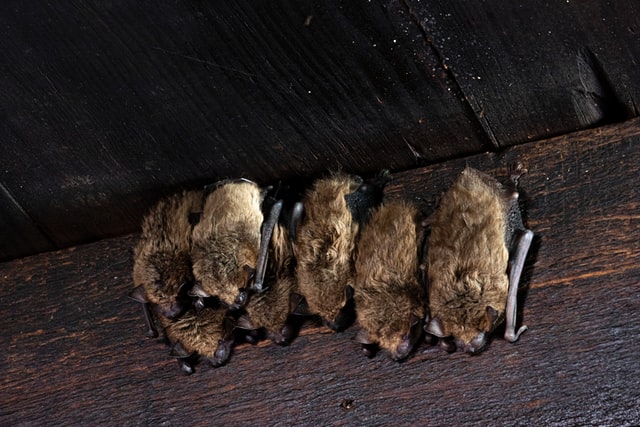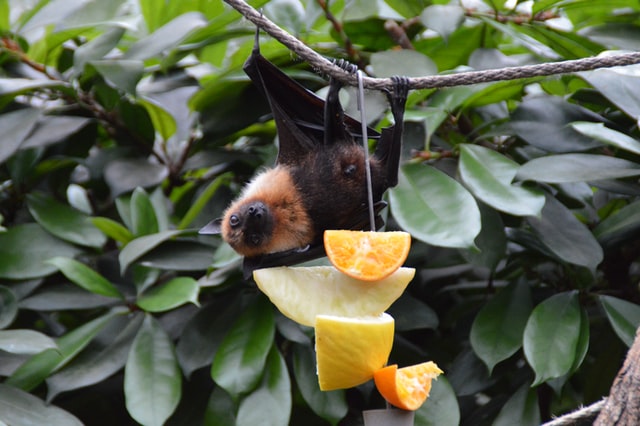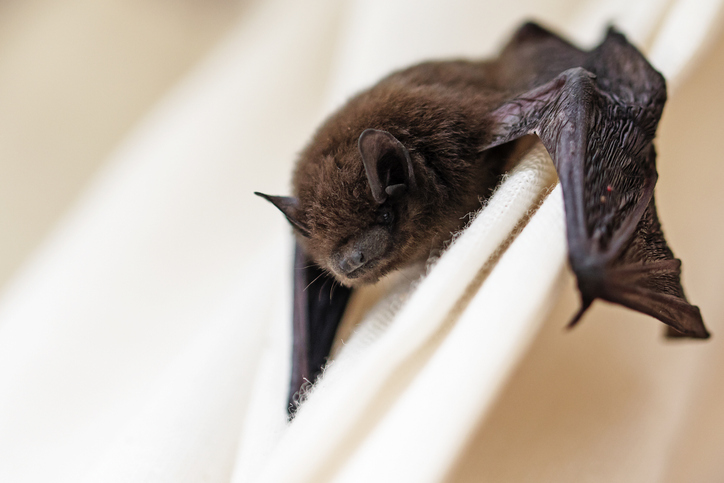Bats are one of the world’s most unique creatures and can be found on virtually every continent around the globe. These flying mammals mostly eat insects, which means that they’re a beneficial part of the ecosystem. Unfortunately, some bats may make their way into your home, which can lead to myriad problems. If you end up with bats in your house, what can you do to get them out in a safe, humane way? This guide covers important information about bats, how to handle one if it does get indoors, and some steps you can take to be proactive and keep them outside, so they won’t enter your home.
Bat Basics

It’s important to learn more about bats so that you understand them. Here are some basic bat facts to give you a more in-depth understanding of these mysterious creatures.
What they do: Bats are the only mammal that can fly. They’re found all over the world—there are approximately 1,300 different bat species spanning the globe. Due to their voracious appetites for insects, they do a wonderful job of keeping pests under control, which is particularly beneficial to farmers and backyard grillers.
Common types of bats: In the United States, the most common types of bats you may encounter include the free-tailed bat, big brown bat, pallid bat, or the little brown bat. There are many others, but these tend to be the most common species that could potentially make your house their home.
Why we should protect them: Bats may seem frightening, but bat conservation is actually important for our planet. Not only can just one bat eat an average of 3,000 insects every night, but some are also important pollinators. Bats that feed on fruit or flowers, contribute to a healthy pollination process. Bat poop, called guano, is great for the garden, guano of fruit-eating bats contains seeds of various plants, which get spread over long distances, contributing to healthy, widespread plant growth.
Why bats could end up in your home: If a bat needs a new place to roost, they may decide that your home is a good place to do so. Most bats end up in the attic, under flashing, in soffits, or wall spaces. Many bat species can squeeze through cracks and crevices, so if they see an entry, they may use the space to live and rear their young. Sudden drops in temperature may also encourage bats to find a warm place like your attic until the cold subsides.
Risks involved: While most bats are harmless, a small number can be infected with the rabies virus, a dangerous disease that can be caught by most mammals, including humans. You can contract rabies if you are bitten or scratched by a bat that has the virus, but on average, just five percent of suspect bats that are tested are positive for the rabies virus. These flying mammals have also been implicated in the spread of histoplasmosis, a fungus that is typically found near the Ohio and Mississippi rivers. Fungus spores from soil contaminated by bird or bat droppings can spread to humans if inhaled, although most symptoms are mild and serious issues like fever are quite rare.
It’s worth noting that the protection from rabies is easy, never handle a wild or unfamiliar animal, always vaccinate pets, but most importantly, always report any bite. Also that most cases of histoplasmosis are associated with large accumulations of pigeons and chicken droppings.
Bat Indoors

If you find a bat inside your house, there’s no need to panic. Here are some things you can do to get it outside safely. Bats are not aggressive but may bite in self-defense.
Gear to use: Always handle bats with care, and make sure you wear gloves to avoid getting bitten. Leather work gloves are a good choice. You’ll also need a large jar, sturdy cardboard box, coffee can, or another container to trap the bat in, and a piece of cardboard that’s larger than the opening to contain the bat until you’re ready to release it.
Handling bats humanely: If you’re able to capture the bat in the container, take it outside and gently remove the cardboard so the bat can escape. Never release a bat on the ground, since they cannot just take off and fly as birds can. Instead, tilt the container at an angle near a tree or other object where the bat can climb vertically until it reaches a safe location. Don’t leave a trapped bat for long, or it could suffocate or starve. Make sure you’re ready to release the bat as soon as you capture it.
Contact the experts: It’s not recommended that the average homeowner attempt to handle a bat in the house. Thankfully, there are experts who can assist you in removing bats safely from your home. Start by contacting a local animal rescue or rehab center, or your local Humane Society. If they can’t assist you, your local wildlife or game and fish department should be able to help. Some pest control companies also know how to remove bats—but always confirm that they’re qualified and experienced to do so in a safe and humane way.
Keeping Bats Safe Outside

The best way to avoid dealing with bats in your house is to provide them with a safe haven outdoors. Here are some tips to help you create a safe environment for bats.
Build a bat house. You can build a DIY bat house or bat box, or you may purchase one that’s pre-made to provide bats with a safe shelter. Build your bat house with sturdy pieces of wood. You can download designs online and use a saw, screws, and nails to construct the bat house.
Place the bat house at least 10-12 feet off the ground, facing south to southeast. The best location will be where the bat box gets early morning sunlight and continues to get full sun throughout the day. The ideal temperature for bats is between 85 to 100 degrees Fahrenheit.
Keep the bat house away from trees where birds of prey may try to eat them. A tall pole is a good alternative—but never attach it to an active utility pole—or if you want, you can attach the box directly to the side of your house. Make sure that the bat box is at least one-quarter of a mile within a water source and maintain it by painting it with a quality, exterior latex paint. Never attempt to move your bat house if there are currently bats inside. Often, parents will raise baby bats in the bat box to keep them safe until they’re old enough to venture out on their own.
Monitor pets outside. Pets, especially cats, are predators of bats. A curious pet may swat at a bat or attempt to kill it, so it’s important to keep your animals away from the bat house. You don’t have to keep your pets inside all of the time, but make sure you watch them and monitor them closely whenever they’re let out to ensure that they don’t try to get into the bat house or attempt to harm a bat that may be flying by.
Don’t use pesticides. Chemicals in pesticides can cause serious harm to bats. If the pesticides get into the animals’ food source, they can have toxic, deadly consequences. Instead of keeping pests away using synthetic pesticides, look for organic, all-natural alternatives to keep bats and birds safe. You can make your homemade organic pesticides using a variety of ingredients like neem oil, a simple Himalayan salt spray, or mineral oil.
Prevent bats from entering your home. If you want to keep bats away, there are several things you can do. Get bat control products. Seal all gaps and cracks around the perimeter of your home, particularly near the attic. Look for any areas where light comes in. If you see sunlight coming in through these areas, it means that bats and other pests can easily come inside. It’s important to keep in mind that these precautions may prevent bats from leaving and are recommended to be used outside of baby season, and only if you have confirmed no bats are present.
Fill gaps and holes with caulk or stainless steel mesh screens. Check the fireplace vents and chimneys to ensure that they’re closed off with a well-fitting, protective cap. Look for any loose trim or fascia on your house, and make sure that it’s securely attached to the frame. If you have a tile roof, install rigid mesh in gaps between the tiles so bats don’t attempt to gain entry. Not only will these measures keep bats out of your home, but they’ll also prevent other pests from entering, too.
Although bats are often misunderstood by humans, more people are beginning to understand their importance when it comes to preserving and promoting a healthy environment. If you keep bats out of your home and make their environment safe, these important mammals will continue to thrive. Never attempt to handle a bat if you’re not sure how to do so safely. Instead, contact professional animal rescue organizations in your area, and they will be happy to help you remove and relocate the bat or bats safely. When we learn to coexist with animals, it helps to ensure a better world for future generations to come.




